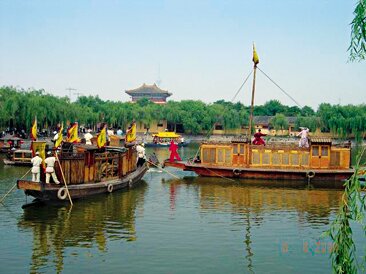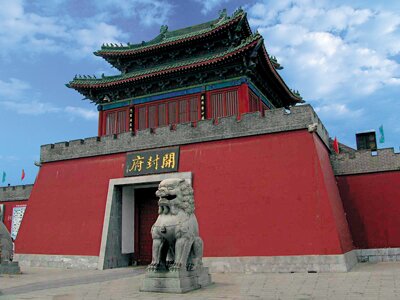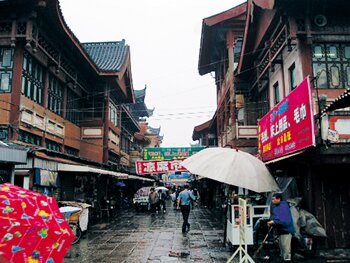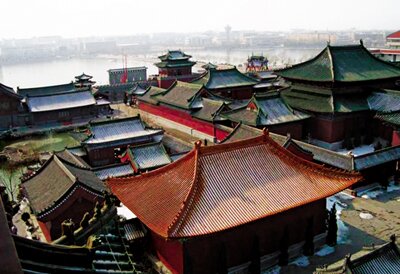|
Kaifeng, in the northeastern Henan province of China, is located along the southern bank of the Yellow River. It is a quiet city, seemingly left behind in the country's race to modernity due to strict zoning laws preventing the construction of skyscrapers.

Kaifeng, located on the Southern bank of the Yellow River
|
Kaifeng is one of the Seven Ancient Capitals of China, was once a major commercial hub and in the 11th century it was the largest single city in the world. It was also once home to a nearly forgotten group of Jews.
The Jews of Kaifeng were once an affluent group and numbered some 4,000 members in the 16th century. The community was known as adherents of tiao jin jiao (the religion which removes the sinew). The reference is taken from a passage in Genesis.
Accounts suggest the Jewish community existed in Kaifeng since the mid Han Dynasty which spanned from 2 BCE through 2nd century CE.

Kaifeng, one of the Seven Ancient Capitals of China
Â
|
The Jewish presence in Kaifeng from the Southern Song Dynasty through the late nineteenth century is however clearly documented. Records carefully detail their synagogue as well as numerous religious artifacts including three steles with inscriptions. The oldest of these steles is dated 1489 and commemorates the construction of the community’s synagogue in 1163. This first synagogue of 1163 was destroyed by a flood in 1461. It was rebuilt and refurbished only to succumb to forces of nature again.
Translations of the steles reveal much about the community. They indicate that the Jews entered China from India in the mid Han Dynasty. Seventeen clan names were listed on the stone monument of 1489, but subsequent research only verifies eight of these names: Shi, Ai, Gao, Jin, Zhang, Zhao, and Li (with two clans using the name Li). From this discovery, the community was often referred to as “The Eight Clans with the Seven Surnames.†They lived in a tolerant society and were even welcomed to settle by the Emperor who declared, “You have come to China. Keep and follow the customs of your forefathers.â€
A second stele was dated 1512 and a third is dated 1663 and commemorates the re-rebuilding of the Qingzhen si synagogue and recaps the information from the other two steles. The records indicate that the synagogue was again destroyed by flood, the Huang He flood in 1642.

Modern day Kaifeng
Â
|
The synagogue was rebuilt one last time. It was destroyed by floods in the 1850s. With little money left in the community, after this collapse the synagogue remained in disrepair. Little remains of the Kaifeng Synagogue. It is actually now the boiler room of the No. 4 People’s Hospital, built in 1953. Â
At its height, everyday secular life of the Kaifeng Jewish community did not differ much from their compatriots. Their hair was fashioned in traditional pigtails, the women had their feet bound and they all wore the same silk robes as their neighbors. While they likely came to China first as merchants, once settled they were a diverse community of farmers, merchants, artisans, scholars, military officials, civil servants, soldiers, and doctors. Their success and contributions are said to have exceeded their small numbers. (During its heyday the city’s populations reportedly exceeded 1.5 million.)
The Jewish community was known for its hard work and scholarship. Many were elevated to the mandarin rank. This distinction, abandoned in the early 1900s, was reserved the most respected civil and military leaders. Two brothers Zhao Yingcheng (Moshe ben Abram) and Zhao Yingdou achieved this coveted rank, held high governmental posts and were vital forces in the rebuilding the synagogue after the flood of 1642.
 In its own heyday, the synagogue attested to the wealth of Jewish spiritual life in Kaifeng. It was surrounded by additional structures, including a ritual bath, a communal kitchen, a study hall, and a kosher butchering facility.

Strict building laws prohibit construction of skyscrapers in Kaifeng
Â
|
 The children were given Hebrew names in addition to popular local names, a practice common to Jewish communities throughout the Diaspora. The rite of conversion was practiced when members of the Jewish community married non-Jews, they knew Hebrew, studied Torah, practiced circumcision, prayed facing westwards towards Jerusalem, observed holidays including Shabbat, Pesach and Yom Kippur, and only ate meat prepared in accordance with the requirements of Jewish law.
The ancient “Lane of the Sect which Teaches the Scripturesâ€, which was the street that led to the synagogue, still bears the name “South Teaching the Scripture Lane†on its street sign. As far as structures or artifacts, little else remains in Kaifeng yet this is still the best documented ancient Jewish community in China.
Many extraordinary records were taken from the detailed journals of numerous European visitors, mainly missionaries who were amazed at the discovery of this community so far removed from all major arteries of Jewish life. The community’s own six Torah scrolls and sixty or so prayer books had been sold to Christian missionaries and are now part of museum collections worldwide.
There has been a recent revival in interest among scholars in the area of the Jews of China and large number of publications that cover the subject. The search continues to save these relics of the past.
Â
(Issue April 2007)Â
Â
|




